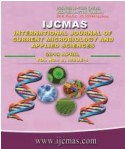


 National Academy of Agricultural Sciences (NAAS)
National Academy of Agricultural Sciences (NAAS)

|
PRINT ISSN : 2319-7692
Online ISSN : 2319-7706 Issues : 12 per year Publisher : Excellent Publishers Email : editorijcmas@gmail.com / submit@ijcmas.com Editor-in-chief: Dr.M.Prakash Index Copernicus ICV 2018: 95.39 NAAS RATING 2020: 5.38 |
Soybean is a major kharif crop of Kota district, which accounts for more than 50 percent acreage of kharif sown area of the district. Front line demonstrations (FLD’s) on soybean crop were conducted during kharif seasons of year 2016 to 2018 in 140 ha area on 340 farmer’s fields in 17 different villages of operational area of Krishi Vigyan Kendra, Kota to demonstrate production potential of improved agro-techniques. Technological interventions demonstrated consisted of use of variety JS 20-29 & JS 95-60, seed treatment with carbendazim50 WP @ 2.0 g /kg seed & inoculation of rhizobium & PSB culture, sowing in 30 cm rows apart, recommended doses of NP fertilizers (80-40 kg/ha) and zinc sulphate 20-25 kg/ha, weed management by application of Sodium acifluorfen 16.5%+Clodinofop-P 8% EC @ 1000 ml/ha 20-25 DAS and need based plant protection measures taken as spray of Thiocloprid 24 SC @ 750 ml/ha for girdle beetle, Trizophos 40 EC 1.0 Litre /ha or Indoxcarb 15 EC 300 ml/ha for semilooper. A study of three years data revealed that demonstrated techniques recorded substantially higher soybean yield than that under existing farmer’s practice with mean seed yield of 1562 kg/ha which represents 26.23 per cent yield enhancement over farmer’s practice (1227 kg/ha). Improved techniques fetched average net returns of Rs 28313/ha with B:C ratio of 2.05, higher in comparison to farmer’s practice (Rs 20019/ha, B:C ratio 1.95). An average additional returns of Rs.10623/ha was obtained due to application of improved techniques with incremental B: C ratio of 4.58. Yield gap analysis showed extension gap in the range of 227 to 370 kg/ha, emphasizes the need for transferring the feasible improved technologies among farmers to bridge the extension gap. Technology index in the present study varied between 35.16 to 42.20 per cent.
 |
 |
 |
 |
 |